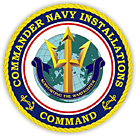| This article needs additional citations for verification. Please help improve this article by adding citations to reliable sources. Unsourced material may be challenged and removed. Find sources: "Commander, Navy Installations Command" – news · newspapers · books · scholar · JSTOR (December 2017) (Learn how and when to remove this message) |
| Commander, Navy Installations Command Navy Installations Command (UIC - 00052) | |
|---|---|
 CNIC Seal CNIC Seal | |
| Active | 1 October 2003 - present |
| Country | |
| Branch | |
| Type | Enterprise Command |
| Role | Manages, operates, controls and supports naval installations and activities |
| Headquarters | Washington Navy Yard, Washington, DC |
| Nickname(s) | CNIC |
| Motto(s) | "Sustaining the fleet, enabling the fighter, supporting the family" |
| Website | cnic.navy.mil |
| Commanders | |
| Commander | VADM Christopher S. Gray |
| Deputy Commander | Mr. Timothy K. Bridges, SES |
The Commander, Navy Installations Command (CNIC) is an Echelon II shore command responsible for all shore installations under the control of the United States Navy. As an Echelon II command, it reports directly to the chief of naval operations. It is responsible for the operation and management of all Naval installations worldwide through eleven Navy regions.
Mission
Prior to the creation of CNIC, all of the Navy's major shore echelon II commanders (BUMED, NAVSEA, NAVSUP) operated their own installations independently. This led to a hodgepodge of operating procedures, that, when installations operated in close proximity to one another, resulted in sometimes incompatible and significant policy differences. Thus, it was the intent of CNIC to establish a single shore installation management organization that will focus on installation effectiveness and improve the shore installation management community's ability to support the fleet. When it was established October 1, 2003, the stand up of CNIC was an effort in the continuation of fleet and regional shore installation management organizational alignment that began in 1997 with the reduction of installation management claimants from 18 to 8.
Operations

CNIC has overall responsibility and authority for all installation support programs and is the lead for Navy installation policy and program execution oversight. CNIC works to coordinate services across the Naval Enterprises (aka shore Echelon II commands), and best provide the installations, services and programs in their support. These services include installation management and operations, such as port operations, airfields, security, utilities, land use planning, environmental aspects, planning and real estate, and emergency management, as well as fleet support services such as base housing, weapons storage, MWR (Morale, Welfare and Recreation) recreational programs, child care and youth programs.
Its mission is summed up as supporting the three 'F's: "Fleet, Fighter and Family".
- "Fleet" means the operating forces of the Navy. CNIC ensures all installation requirements necessary to train and operate the Fleets (Ports, Airfields, Training Ranges, etc.) are maintained and ready.
- "Fighter" means the men and women in the operating forces. CNIC ensures naval installations are able to facilitate the manning, training and equipping of the Navy's fighting force.
- "Family" means the men and women of the armed forces and their families. To ensure the fighting force is supported on all fronts, CNIC's Family and Community Services, Housing and Safety efforts provide the quality of life, support and services that allow the fighting force to focus on mission accomplishment.
Regions
Historically, each region was a part of one or other United States naval districts from their inception in the early 1900s until their disestablishment in the late 1970s and 1980s. At that point, individual installations were typically operated independent of any true centralized command structure. In 1998, the Navy embarked on a new era in shore management, with San Diego leading the way. As the Navy reduced its operational forces, it became essential for the shore establishment supporting those forces to be realigned.
As part of the new command structure, each naval installation or supported command now reports to one of eleven regional commanders who are responsible for the operation and management of the installations within their regional jurisdiction. Each regional commander is a one-star rear admiral (RDML) with the exception of the commanders of Navy Region Mid-Atlantic, Navy Region Japan and Navy Region EURAFCENT, who can be two-star rear admiral (upper half) (RADM).
Former regions
Navy Region Midwest was disestablished on September 30, 2014 as part of a reorganization of Navy flag billets assets in the wake of the United States budget sequestration in 2013. Formerly headquartered in Great Lakes, Illinois, it included installations in 16 states. These are now split between the Northwest, Mid-Atlantic, and Southeast regions.
References
- "About". Navy Installations Command.
- Nakahara, Liane. "Navy Region Northwest gets new Region Commander". DVIDS. Retrieved 2021-06-30.
- "Navy Region Mid-Atlantic Change of Command". Navy Region Mid-Atlantic. Norfolk, Virginia. 2024-07-03. Retrieved 2024-07-07.
- Hall, Greg (2022-06-17). "Navy Region Hawaii Holds Change of Command Ceremony". DVIDS. Retrieved 2022-06-18.
- "CNFJ/CNRJ Holds Change of Command Ceremony". DVIDS. 2024-06-26. Retrieved 2024-06-27.
- Defense Media Activity - Navy, Staff Writer. "Navy Announces Plan to Reduce Flag Officer Structure". Retrieved 2016-07-22.










